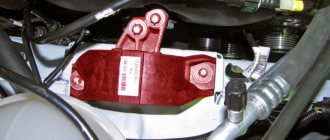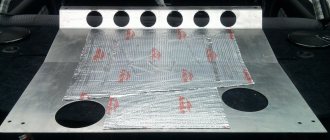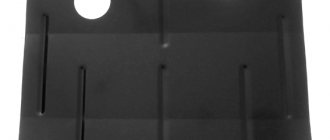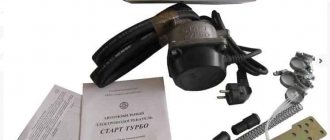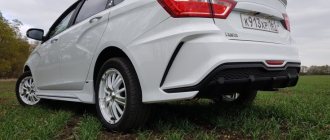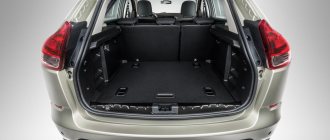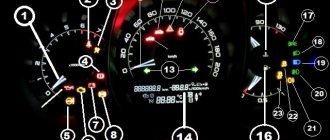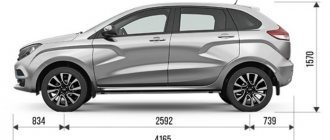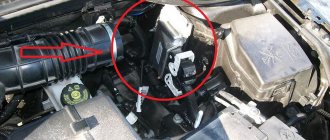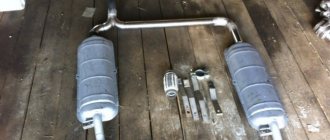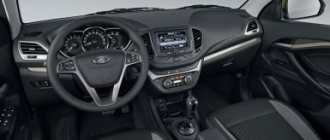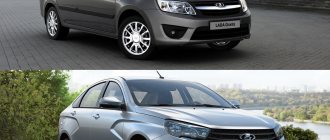The standard protection of a Lada Vesta car is a thin sheet, which, if hit well, will not cope with its purpose - this is typical for all AvtoVAZ cars. Therefore, you need to install thick protection - it will protect the engine from crankcase holes. Read the article and your car and you will be safe; the engine boot will never let you down. The engine compartment of the Lada Vesta is filled with almost all “vital organs”. The most basic thing that drives a car is the engine. For long-term, efficient operation, it is necessary to provide the motor with proper care and safety. The crankcase is made of soft material and is most susceptible to deformation and damage during impacts. Such breakdowns can cause car owners problems, wasted time and expensive repairs.
It is important to choose a crankcase protection adapted for the Lada Vesta. A broken power unit sump leads to oil leakage. If you turn off the engine in a timely manner, you may be able to limit yourself to replacing the damaged part. Continuing to drive with a broken oil pan will result in a major engine overhaul.
Standard protection of Lada Vesta
AvtoVAZ tried to adapt the new models of its lineup to the country's road surface as much as possible. Taking into account the maximum load, Vesta’s ground clearance is 171 cm, which is higher than that of a standard foreign car. The engine sump has standard protection (article 1 06029 1), which does a good job of limiting the impact of dust, water, and dirt on the engine compartment, but is unlikely to withstand serious impacts. That’s why people call it the engine boot, or the engine mudguard. One of the reasons why Lada Vesta owners refuse to install an engine protective shield is the reduction in ground clearance. Increased ground clearance will not protect the crankcase and gearbox from impact, but will make it possible to fix the part without causing inconvenience to the driver. Compared to the positive aspects for engine integrity, this minus is insignificant.
Leave the original one or install a new one
The standard engine cover is made in the form of thin shields that protect the engine compartment from water, dirt, and dust. There is no reason to count on the fact that this can protect the power unit from serious impacts. For safe engine operation, it is important to select an adapted plate. All the engine oil may leak out of a broken sump on a Vesta: in this case, you will have to remove the housing part for repair or replacement.
Manufacturers of many cars warn owners that non-original plates installed on the engine crankcase can lead to quite serious consequences. A metal or durable plastic element is rigidly attached to the subframe. In this case, the engine does not shift along the calculated trajectory, but into the passenger compartment, endangering the legs of the driver and passenger.
Installing motor protection
It is up to the car owner to decide whether to leave the standard system or install a third-party system. The reluctance of some drivers to install a protective body element is argued by the fact that this can reduce ground clearance. However, the ground clearance of the Lada Vesta is quite respectable - 171 mm, which will reliably protect the engine sump without much damage. The benefits of installing the device largely compensate for the slight decrease in ground clearance. It is better not to bring the situation to the point of removing the aluminum pan on the Lada Vesta.
Note that an incorrectly manufactured shield can change the passive safety of the car and worsen the outcome of a traffic accident, especially in a frontal impact.
Steel
This material is in greatest demand, since this option combines two selection criteria: price + quality. 2 mm thick steel sheets perfectly protect the crankcase. The average service life of steel protection is 7-10 years; in case of deformation, it can be easily restored. Such a part is optimal for Lada Vesta, due to its high rigidity and budget cost. Steel protection copes with its main functions, protecting the motor boat and gearbox from damage.
Many car enthusiasts prefer parts with stiffening ribs, believing that the ribs resist deformation by hard, cutting objects. However, there is also an opinion: at critical pressure, the crankcase will better protect a part with a smooth surface, evenly distributing the load. The main disadvantage is considered to be high susceptibility to corrosion, from which even powder coating and special application technology cannot protect.
Reviews
| № | Positive |
| 1 | Andrey (Avtodrom): I live in the city, the roads are good, I don’t need armor. |
| 2 | Sergey (Autotema): I bought metal protection, installed it myself, there’s nothing complicated about it. |
| 3 | Kirill (Autoreview): I’ve been driving a car with built-in armor for three years, no comments. I can’t say that the ground clearance has decreased significantly. |
| 4 | Alexey (Avtoria): a year has passed since the armor was installed, there are no comments, no creaks, no knocks. |
| 5 | Alexander (Drom): I’m happy with the purchase of protection, I often drive on the periphery, I don’t worry about the integrity of the engine. |
| 6 | Stanislav (Behind the wheel): the protection is good, practical, and does not deform. |
| 7 | Vasily Alekseevich (“5th wheel”): Three years have passed since installation, no complaints. |
| Negative | |
| 8 | Vitaly (Avtotema): the mount is not strong enough, sometimes it taps on uneven surfaces. |
| 9 | Svyatoslav (Otzovik.net): the price of original protection is unreasonably high. |
| 10 | Vlad (ProAuto): There are no particular complaints, but the quality of fastening can be improved. |
Reinforced steel
The reinforced version of the steel part has a thickness of 3-4 mm, the weight of the part increases, which significantly increases the load and fuel consumption. Reinforced steel is well suited for crossovers, such as the Lada Vesta Cross, since the large mass provides greater impact force. Restoring such a sheet is almost impossible, and the price is much higher. For maximum protection of the Lada Vesta crankcase, it is possible to use this option, however, drivers often opt for smooth steel in the first option.
Conclusion
Is crankcase protection necessary - definitely yes, for residents of the periphery, where the quality of the road surface is far from ideal.
The process of independently installing crankcase protection on a Lada Vesta car is not complicated, but it requires increased attention and strict adherence to the regulations.
If you encounter difficulties during installation, contact a service station specialist. Car service workers recommend purchasing branded car armor and then installing it, because only the “original” guarantees compatibility with the body structure of your vehicle.
Aluminum
The aluminum protection has a thickness of 5 mm, but this criterion does not affect its weight in any way, but is several times more expensive. The part has high strength and is easy to restore. Compared to other materials, aluminum has a longer service life. The properties of the metal make it possible to increase the dimensions of the part, which makes it possible to protect a larger area from impact.
Don't forget about car safety. The main advantage of the aluminum part is the absence of sparks upon impact, which protects the car from the risk of fire.
The downside of the part is its high susceptibility to oxidation, which significantly affects durability.
What can cause crankcase damage?
The main enemy of protection is off-road conditions, potholes, bumps, and driving on rough terrain. If a sheet of iron comes into contact with the ground surface, the protection deforms.
The second problem is the car’s curb weight of 1300 kg. Hitting rocks and bumps at speeds over 60 km/h damages the metal surface of the armor.
The durability of the aluminum engine sump cover is several times lower than that of steel. Hitting a concrete curb at a speed of 45 km/h causes a crack in the oil pan.
Another important factor that must be taken into account when choosing and installing armor is metal fatigue of sheet steel and the negative impact of different environmental temperature conditions.
Related link:
Vesta SW – is it worth paying extra for the Cross console?
Poor installation of the “sheet” can also cause damage to the oil pan. Loose fasteners sag, bolts break the aluminum pan cover, and engine oil leaks.
Stainless steel
Stainless steel protection attracts car enthusiasts with its appearance - after all, it is stainless. There is no even minimal corrosion on shields made of this material. This option is most often preferred by drivers of jeeps/crossovers, but the considerable ground clearance of the Lada Vesta allows owners to choose this model. The strength of the steel sheet is high, as is the price, which is 2-3 times higher than ordinary steel.
An economical version of the protective shield is also popular - a regular steel sheet with a stainless steel overlay. This option allows you to significantly benefit in price, and the appearance remains at its best.
Protection of the engine compartment.
To protect the engine compartment from hacking and theft of the electronic control unit, a universal electromechanical hood lock kit is used.
UniLock v5 10500 rub. Price with installation
A set of universal electromechanical hood lock, developed by order of experts from the Federal service Ugona.net. Protection against theft, theft of car parts, deactivation of sirens.
In addition to the lock, we recommend installing a steel casing to protect the ECU.
The main principle of protection against theft of Lada Vesta is to install a security system, which involves a set of electronic and mechanical means.
As the main protection, our specialists install the StarLine Expert security system, which represents a fundamentally new approach to creating an anti-theft solution for your car.
Composite materials
Protection from composite materials: fiberglass, Kevlar or carbon fiber, is made by connecting them in layers using epoxy resins as a reinforcing link.
Such protectors are durable, light, completely free from corrosion and oxidation.
Taking into account the materials and binders used in production, the price of elements made of composite materials varies between a couple of hundred and several thousand dollars - so it is not for Vesta.
Due to complex production technology and lack of demand, restoring a damaged protector will become much more difficult. There is a high probability of purchasing a part with an internal defect that is difficult to detect with the naked eye.
Ready-made protection or custom order?
Owners of Lada Vesta, in the vast majority of cases, buy finished products. They are made of steel and are quite cheap. But there are elements made of aluminum, Kevlar, titanium, stainless steel and other materials with higher characteristics. However, manufacturers of components for Vesta do not use them, because installing exclusive protection on a class B car seems inappropriate due to the high costs.
Serial steel protection is not difficult to find in auto parts stores or order online.
However, fans of the model will certainly not be stingy, so the appearance of Russian cars with such protection is quite likely. However, for this, those wishing to do so will have to contact manufacturers or body shops with an individual order.
Manufacturers of crankcase protection
A wide selection of protective elements allows drivers to choose the option that best suits their vehicle. Lada 2180 owners give the greatest preference to the following manufacturers:
| Manufacturer | vendor code | Material | Thickness |
| Sheriff | 27.2928V1 | Steel | 2mm |
| Novline | NLZ.52.28.020NEW | Reinforced steel | 3 mm |
Possible consequences of the accident
Vesta's power unit sump is its weak point. After all, it is made from a fairly soft material and is not able to withstand impacts. Fortunately, if such an accident occurs in the city, there will be no problems calling a tow truck.
On our roads, a broken crankcase is not uncommon.
However, a broken crankcase will cause oil to leak from the engine. If the Vesta owner manages to immediately turn off the engine, most likely he will be able to get by with replacing only the crankcase, although this procedure is very expensive - purchasing new components and work will cost from 20,000 rubles. If it is not possible to immediately turn off the Lada engine, everything may end with a major overhaul of the power unit.
But an even more optimistic option involves obtaining a certificate from the traffic police (after all, this is internal damage), which means unnecessary red tape. In addition, the issue of the quality of the repairs carried out has also not been canceled. Even if all expenses are covered by the insurance company (if Vesta has CASCO insurance), next year insurance prices will be significantly increased.
After such an incident, the insurance company will probably increase prices.
However, things could be much worse. There have been cases when car owners have punctured the crankcase on the highway, far from the nearest city. In winter, in such a case, you will have to rely on the responsiveness of other drivers. The cause of an accident can be anything - from a pothole, to a piece of ice flying off a truck or a dropped load.
Pieces of asphalt can easily cause a broken crankcase.
Installation procedure for the protective element
Like any other product, engine protection has instructions for use. Which you must carefully read before installation and strictly follow the advice of specialists.
Replacing or installing a protective element yourself is not a difficult job; any car enthusiast can do it if he wants. You will need a room equipped with a car lift or a repair pit; in extreme cases, you can use an overpass. It should be remembered that when using two jacks, it is necessary to install safety stops for safety. The standard shield is secured with thirteen bolts; dismantling requires a standard set of wrenches. Before installation, clean and lubricate all holes and screws. Repeat the steps in reverse order and tighten the screws tightly.
Everything is ready for use.
Metal or plastic?
If we consider the material from which the protection is made, there are two types: metal and plastic. Plastic is lighter and, with a strong impact, takes on most of the load, but, as a rule, with the same impact, the plastic protection very quickly becomes unusable. As for the metal one, the likelihood of it breaking is an order of magnitude lower, but other parts of the body may also be damaged in the event of an impact, since the protection is rigidly attached to other parts of the engine compartment. As for other characteristics (protection from dirt, noise insulation), there are practically no differences between plastic and metal construction.
It turns out that plastic engine crankcase protection is the best solution for driving in the city and on the highway. It is better to install metal protection on SUVs and other vehicles intended for driving on rough terrain. Such cars have a frame and the body will not be damaged in the event of an impact.
